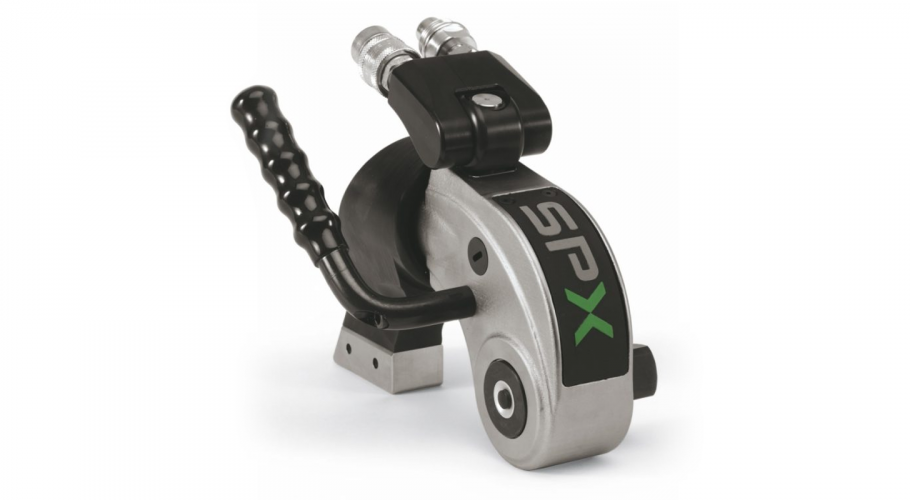
An article designed to provide an introduction to these tools which are increasingly being specified as necessary to ensure safe bolt tightening and break-out procedures and to provide accurate bolt tightening torques.
If you’re reading this article with a view to possibly requiring this kind of equipment in future, then you’re probably someone who knows what a ratchet spanner is. This being so, just think hydraulic ratchet spanner, combine this with extremely accurate tightening torque, and you’re already well along the way to knowing what a hydraulic torque wrench is and what it does. Whilst you may be new to this kind of equipment, it isn’t a new concept. In fact, the hydraulic torque wrench has been around now for more than 40 years and whilst innovation during the intervening years has dramatically reduced the size and weight of the wrenches they remain, essentially, hydraulic ratchet spanners.
There are two main types of hydraulic torque wrench, the Square Drive and the Low Profile wrench (also known variously as Low Clearance/ Direct Fit/ Cassette/ Hex Link wrench). The Square Drive wrench drives a socket whereas the Limited Clearance wrench fits directly on the nut. The vast majority of hydraulic torque wrench tool systems are “double-acting” (hydraulic advance, hydraulic return back over the ratchet) although single-acting (hydraulic advance, spring return back over the ratchet) systems are available and whilst few manufacturers/suppliers cater for this option, the single-acting system can bring advantage in terms of cost and on remote, difficult-to-access bolting applications where a power source is not readily available.
The Square Drive wrench is by far the more versatile of the two wrench options in that it will drive any AF size socket with a suitable drive. The Low Profile wrench requires a bespoke AF size hex link for each size nut which can make it expensive to assemble a suitable range of equipment for all bolt sizes. With good operating habits, both wrench types are easy and safe to use although the Low Profile wrenches are generally more suited to flange work than their Square Drive counterparts. Given a choice on any bolting job where either wrench type can legitimately be used, I would personally opt for the Low Profile wrench as it negates much of the twisting force and reaction challenges often experienced by the Square Drive wrench. Having said that, the Square Drive wrenches find more favour with our customers which is indicative of their much greater versatility and resultant cost-effectiveness.
The wrenches are powered by a hydraulic pump. Most hydraulic torque wrench systems nowadays are designed to work to a maximum pressure of 10,000 psi (710 bar). The pump pressure, as measured by the pump pressure gauge and locked in at the desired rating, dictates the torque output of the wrench. Typically, the pumps are either air or electric powered (usually 110V) although the single-acting wrenches can be powered by any 10,000 psi pump including manual hand pumps. The wrenches are connected to the pump by a high-pressure siamese hose (or single hose for single-acting wrenches) usually around 5m in length although can be any length within reason.
The most commonly used wrenches tend to be 3/4″ and 1″ Square Drive Wrenches with maximum torque outputs ranging from 1000Nm up to 4,000 Nm and their Low Profile counterparts, accommodating nut AF sizes up to 80mm – up to around 5,000 Nm. Beyond these, the Square Drive wrenches ( 1 1/2″ and 2 1/2″ drives) and Limited Clearance wrenches in most tool ranges accommodate tightening torques up to and in excess of 30,000 Nm for working on large bolts.
This equipment is not difficult to use. In fact, it is relatively easy (and safe) to use, but you need to know the good habits and you also need to know that when the wrench manufacturers talk of “one-man, remote operation”, it isn’t always like that in the practical world. In fact, it isn’t like that much of the time and it is when addressing the practicalities of real bolting applications that the good habits need to come into play in the handling and positioning of the wrenches.
Hydraulic torque wrench equipment can be supplied either for sale or hire. Generally speaking, it is the frequency of usage that ultimately determines whether a user elects to purchase or hire although initial “toe in the water” usage is usually best undertaken on hire for a variety of fairly obvious reasons. Thereafter, it is not uncommon for frequent users to purchase core equipment requirements (for example a pump, hoses and one or two tools) and thereafter to hire in different size tools and/or hex links as and when occasional need dictates.
In theory, most hydraulics distributors could source and supply hydraulic torque wrench equipment. But few, very few have the knowledge, expertise, equipment or response to properly back up such supply. Which is why very few choose to do so. For those that do the equipment, back up and standard of customer service is generally excellent although there can of course be exceptions.
About the Author
Graeme Cook is managing director and owner of Gee-Force Hydraulics, a UK supplier of hydraulic tools and equipment specialising in the sale and hire of hydraulic torque wrench equipment. Before setting up the company he spent 23 years with a major UK Bank, the last 6 years of which as a Corporate Manager. He resigned from the bank in 2000 and spent 4 years working for a well-known manufacturer of hydraulic torque wrench equipment before commencing trading in his own right through Gee-Force. He has spent much of his time with companies and users new to this equipment, nurturing them through from initial inquiry to end-use.